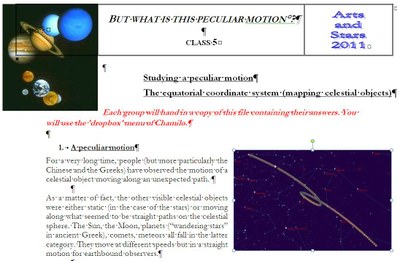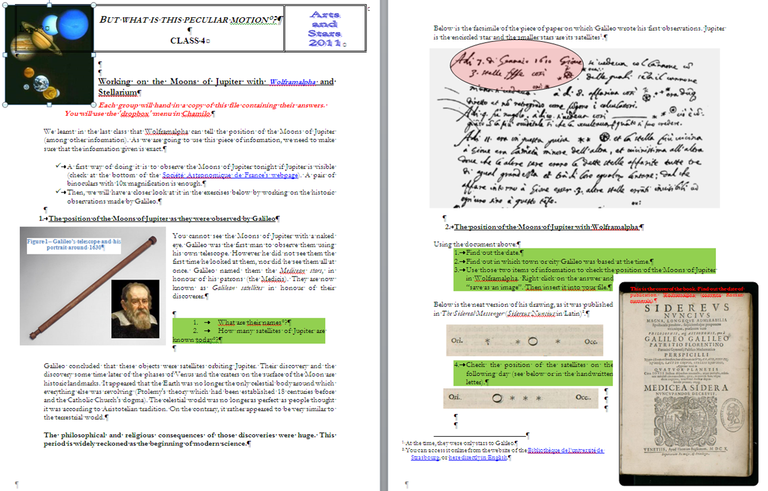A science/ English astronomy-related set of classroom activities
1. General comments on the project:
This resource pack aims at providing astronomy-related activities for the class in science as well as resources and activities to use in the English class, when English is taught as a modern language.
In science, the focus is obviously on scientific activities (carried out in English), introducing notions and skills related to one of the most important periods in the history of science – the early XVIIth century. The aim is to put pupils actively to task, by groups of 2 or 3, allowing them enough time to understand and memorize key issues.
In the English class, the focus is on the four skills – reading, listening, speaking and writing – and the scientific contents provides the class with the cultural dimension of learning.
The resource pack was developed to teach the significance of the scientific revolution to 15- to 16-year-old pupils in an upper secondary school in France (first and second years in upper secondary school).
Two very relevant activities created by M. Cauchois and P. Merlin and dealing with Mars retrograde motion and the calculation of its orbit could be two very challenging follow-up activities. They were created with the same historical purpose.
It was designed so that the activities can be used in parallel in English and science classes and appear to the pupils to be clearly linked up. When designing those activities we aimed at the highest possible level of consistency. In short, the activities carried out in the English class aim at building up the pupils' wider scientific knowledge from a cultural and historical point of view.
Therefore, our other main concern was the building up of a clear and straightforward (but not simplistic) scientific background, using English as the main media.
At the end of the sequence, pupils should be aware of :
- the significance of the historic scientific landmark of the 16th and 17th centuries,
- the key role played by Copernicus, Galileo and other leading astronomers, in establishing heliocentrism as the alternative and sustainable model to geocentrism, a model which had been firmly established 1,400 or so years before and which had never been questioned ever since,
- the scale of the change in scientific, technical, philosophical and religious terms and its scientific legacy.
Pupils will also be introduced to an astronomy dedicated software, an advanced computational software and a scientific search-engine.
2. The activities:
As a result, the resource pack is divided into two sections :
2.1 Scientific activities :
The overall frame consists in discovering and studying a peculiar star-motion in the sky (Mars retrograde motion), and gradually understand what happens. By doing this, we put the emphasis on basic calculation abilities, the use of appropriate softwares and the understanding of the cultural and historical background.
Each activity is designed to last between one and two hours. Ideally, all activities would be carried out using ICT in general and an e-learning platform in particular. Groups use these tools to carry out activities and share documents they have to hand in. They communicate with the teacher in the same way. It’s thus easy/ convenient for the teacher to provide them with interesting files or web-links.
It is to be kept in mind that it takes all the more time to thoroughly tackle a specific scientific problem as first-year pupils in upper secondary schools generally lack autonomy.
The fluidity of the whole sequence depends very much on the teacher's role which is quite difficult to determine. For example, he has to cope with the groups' different working paces and drive what has to be done as homework from one class to the next.
The corpus of documents for the science class is composed as follows:
- Classes 1 and 2 : Activities on orders of magnitudes to check the pupils’ ability to carry-out rapidly relevant calculations on astronomical topics (fields such as distances, energies, times or speeds are covered). A CAS (Computer Algebra System) is introduced to provide exact results, algebraic calculus, units conversions and order of magnitudes.
- Class 3 : Activities on a few important astronomy formulas and Wolframalpha (used as a scientific search engine).
- Class 4 : Starting from a Galileo’s facsimile, the discovery of Stellarium and Wolframalpha as tools to study an astronomical configuration.
- Class 5 : Activities on the celestial coordinate system and the unveiling of our unknown star.
2.2 Linguistic activities :
We mainly provide a selection of documents with guidelines to use them in class, as all activities are meant to be adapted to the specificities and of each class and requirements of the different educational curricula.
The corpus of documents for the English class is composed as follows:
- Two videos: « Cosmic Voyage » and « Powers of Ten » : the main focus is on building up vocabulary dealing specifically with astronomy that is why it seems relevant to work only on the first part of either of the two videos (the second part deals with negative powers, thus going to the small-scale world). Some grammar points are outlined but follow-up activities would need to be carried out in class according to the specific requirements of the class.
- A scientific timeline based on edited extracts from eight famous astronomers, ranging from Aristotle to Sir Isaac Newton.
- A collaborative project work whose purpose is to have a more in-depth look at the lives and achievements of four famous astronomers: Aristotle, Ptolemy, Nicolaus Copernicus and Galileo Galilei. The project work can be carried out by using a selection of web links from which teachers will be able to make their choice according to their classes' abilities. The process of the project is developed in a specific file.
- Activities on two videos dealing with an overview of the switching from geocentrism to heliocentrism and the philosophical and religious upheaval it caused.
- Reading activities on a text extracted from the Galileo Project website dealing with The Inquisition.
Most documents are accompanied with worksheets and a selection of web links.
Authors:
Christian Marchal: christian.marchal@ac-aix-marseille.fr
Fabien Jeannier: fabien.jeannier@ac-aix-marseille.fr
Lycée général et technologique Aristide Briand
20 avenue du Commandant Dumont
05 000 GAP / FRANCE
Document Actions

